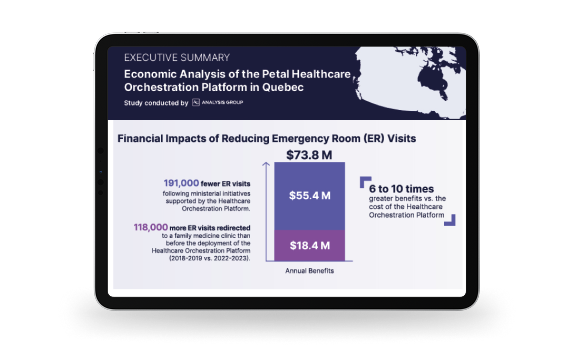Key takeaways
- Canada needs roughly 49% more family physicians (22,823) to cover the care needs of Canadians today given only ~1,300 new graduates enter the workforce per year.
- This persistent shortage overwhelms existing healthcare staff, forcing them to carry heavier caseloads and work longer hours, which accelerates burnout and attrition by restricting work-life balance.
- Technological tools provide support. Among them, Petal Workforce Hub help relieve this pressure by optimizing schedules, improving visibility across teams, distributing shifts equitably, honors staff preferences, and automates last-minute changes based on department rules.
Patients want consistent, reliable care. But Canada’s healthcare system is at an inflection point—access to care is under severe strain.
Since 2019, Canadian emergency departments (EDs) have collectively been closed for 47,500 days, according to The Globe and Mail.1 In 2024, one out of every five hospitals with an ED or urgent care centre had unplanned shutdowns.2
The proportion of Canadians age 18 and older with access to a primary care provider declined from 93% in 2016 to 86% in 2023. There is a deficit of 22,823 family physicians in Canada with only ~1,300 new graduates per year3, and the Canadian government expects a shortage of 78,000 doctors by 2031 and 117,600 nurses by 2030.4
Moreover, antiquated data practices among provincial bodies and independent physicians make accurately evaluating access to care difficult. A 2024 survey of physicians from the Canada Medical Association found that 73% of respondents cited poor system integration or multiple unconnected systems as major challenges.5
The scarcity of doctors, nurses, and other essential healthcare professionals combined with outdated data management places immense strain on Canada’s public health system. The headwinds are clear: factors leading to strain highlight areas for improvement.
Healthcare providers feel access to care strain most
Several factors contribute to the shortage of healthcare providers, creating a complex web of barriers. Attrition rates and burnout among healthcare workers are two of these factors.
In Quebec, about 43% of nurses are leaving the profession before 356, and turnover rates for nurses in hospitals increased by nearly 10% in 2022 compared to pre-pandemic rates.7 Vice-President of the Fédération des médecins spécialistes du Québec Dr. Serge Legault said staffing challenges at his hospital caused operating room activity to decrease by 15%.
The phenomenon of healthcare professionals leaving the field poses significant challenges to delivering quality patient care in the context of an aging population. This estimated shortage underlines the urgency of addressing these turnover rates to maintain effective healthcare delivery.
Petal transformed operations at the University of Montreal Hospital Centre.
Resource strain leads to caregiver burnout
Burnout among healthcare workers has risen in recent years, driven by the profession’s daily demands, long working hours, and reduced vacation time. For instance, 49% of family doctors surveyed by the College of Family Physicians of Canada reported working beyond their desired capacity.8 High or severe work-related burnout is experienced around four times more by family physicians working beyond their desired capacity. During the spring of 2022, 266,900 healthcare workers reported working overtime—the highest number ever.
In Canada, 79% of the health workforce reports feeling burnt-out.9 This contributes to high turnover rates in the healthcare industry: providers may feel compelled to leave their positions for a healthier work-life balance, exacerbating the shortage of skilled healthcare professionals.
This is a cycle that puts pressure on clinicians and patients alike. Solutions cannot be piecemeal but centred on breaking the cycle of system strain leading to burnout. They begin with a focus on coordinated care and unlocked time.
Solutions to address public health challenges and provider burnout
Health organizations must consider interventions that mitigate burnout, prioritize the well-being of their healthcare providers, and encourage a healthy work-life balance.
Technological tools provide an immediate solution. Petal Workforce Management distributes shifts equitably, honors staff preferences, and automates last-minute changes guided by users’ department rules. This led to improved work-life balance and a 92% staff satisfaction rate at the University of Montreal Hospital Centre. This same partnership decreased Department Chiefs’ time spent creating schedules by 98%, lessening administrative burden and allowing more time for patient care.
To address data challenges, four Canadian medical organizations jointly formed a Digital Health Interoperability Task Force. This aims to improve patient care and ease administrative burden by more efficiently sharing, analyzing, and reporting information between independent physicians and medical departments. Here, Petal provides advanced support by equipping healthcare professionals with secure analytics and reporting tools proven to enhance workflows and unify coordination.
Canada must lay foundations today to meet pressing healthcare challenges. Future generations count on it.
Learn how Petal eases administrative burden on managers and staff:
- Grant, K., Tu Thanh, H., & Sun, Y. (2025, July 4). The toll of Canada’s ER closure crisis. The Globe and Mail. https://www.theglobeandmail.com/canada/article-secret-canada-emergency-rooms-closures-hospitals/
- Canadian Institute for Health Information (2023). International survey shows Canada lags behind peer countries in access to primary health care. Commonwealth Fund survey. https://www.cihi.ca/en/international-survey-shows-canada-lags-behind-peer-countries-in-access-to-primary-health-care
- Reimer, Joss (2025, January 21). Ground-breaking new report reveals Canada can’t train enough doctors and other health professionals. Unless we dramatically change how we do things. Canadian Medical Association. https://www.cma.ca/about-us/what-we-do/press-room/ground-breaking-new-report-reveals-canada-cant-train-enough-doctors-and-other-health-professionals
- Canadian Medical Association (2024, September 12). Canada Health Infoway, Canadian Medical Association Survey Shows Physicians are Embracing Connected Care Solutions. CMA. https://www.cma.ca/about-us/what-we-do/press-room/canada-health-infoway-canadian-medical-association-survey-shows-physicians-are-embracing-connected
- Health Canada (2024, July 11). Supporting Canada’s health workers by improving health workforce research, planning and data. Government of Canada. https://www.canada.ca/en/health-canada/news/2024/07/supporting-canadas-health-workers-by-improving-health-workforce-research-planning-and-data0.html
- IEDM/MEI (2024, September 4). Quebec: 43 out of every 100 new nurses are leaving the profession before turning 35, finds new MEI report. IEDM/MEI. https://www.iedm.org/quebec-43-out-of-every-100-new-nurses-are-leaving-the-profession-before-turning-35-finds-new-mei-report/
- Greig, Kelly (2023, May 5). Turnover rates for nurses in Quebec hospitals are higher than in pre-pandemic times. CTV News. https://www.ctvnews.ca/montreal/article/turnover-rates-for-nurses-in-quebec-hospitals-are-higher-than-in-pre-pandemic-times/
- Duong, D., & Vogel, L. (2023, February 27). Overworked health workers are “past the point of exhaustion.” Canadian Medical Association Journal, 195(8), E309–E310. https://doi.org/10.1503/cmaj.1096042
- Singh, J., Poon, D. E. O., Alvarez, E., et al. (2024). Burnout among public health workers in Canada: A cross-sectional study. BMC Public Health, 24, 48. https://doi.org/10.1186/s12889-023-17572-w

![PT_VOMBSFP_202509_EN[1]](https://www.petal-health.com/wp-content/uploads/2025/10/PT_VOMBSFP_202509_EN1.png)
![Rapport économiquepouce-non-arrière-plan(1)[1]](https://www.petal-health.com/wp-content/uploads/2025/10/Economic20report20thumb-no20background2011-768x548.png)